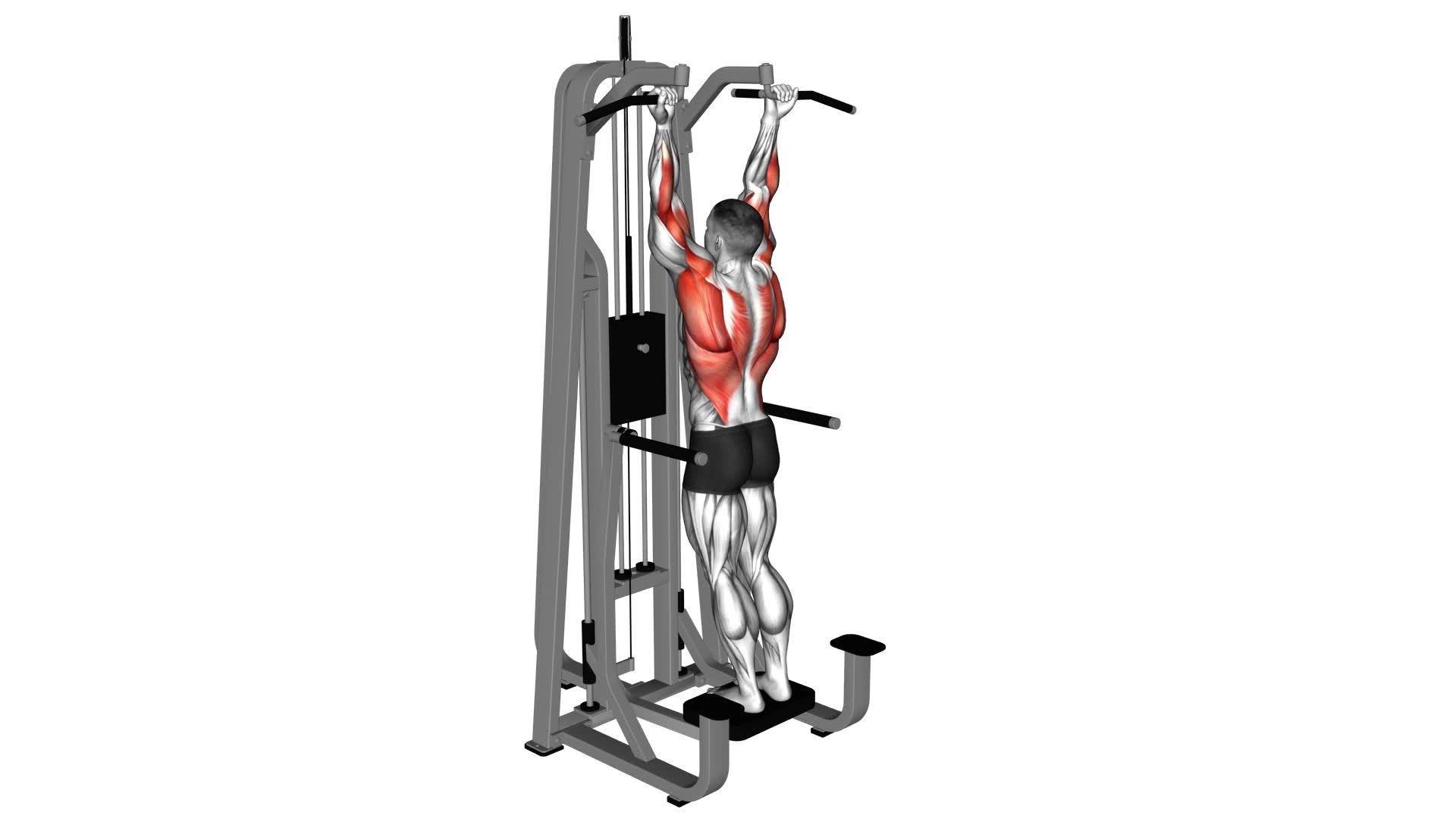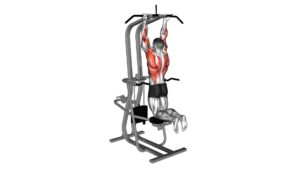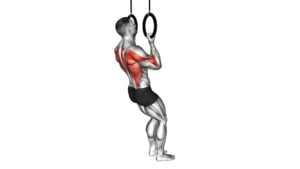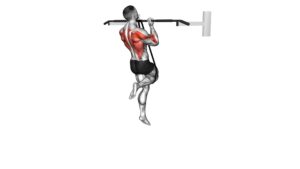Lever Assisted Standing Chin-up – Video Exercise Guide & Tips

Are you looking to improve your upper body strength and tone your muscles?
Watch This Exercise Video
Then the lever assisted standing chin-up is the exercise for you!
In this video exercise guide, we will show you the proper form and technique to perform this challenging exercise.
With our helpful tips and modifications, you'll be able to avoid common mistakes and progress to more advanced variations.
Get ready to take your chin-up game to new heights!
Key Takeaways
- Lever Assisted Standing Chin-up targets back muscles, improves overall upper body strength, builds a stronger core, and targets biceps and forearms.
- The equipment needed for Lever Assisted Standing Chin-up includes a sturdy bar, resistance bands for assistance, and selecting bands that match your strength level.
- Proper form and technique for Lever Assisted Standing Chin-up include standing with feet shoulder-width apart, grasping the bar with an underhand grip, engaging the core, and pulling the body up towards the bar.
- Variations and modifications for Lever Assisted Standing Chin-up include adding weight plates or holding a dumbbell to increase resistance, using resistance bands, using a stability ball or elevating feet for added difficulty, and focusing on proper form techniques to maximize results and avoid injury.
Benefits of Lever Assisted Standing Chin-up
You will experience several benefits from incorporating lever assisted standing chin-ups into your workout routine. One of the primary benefits is the muscles targeted during this exercise. Lever assisted standing chin-ups primarily work your back muscles, including the latissimus dorsi, rhomboids, and trapezius. These muscles are responsible for pulling your body weight up towards the bar and play a crucial role in improving your overall upper body strength.
Incorporating lever assisted standing chin-ups into your workout routine can also help you build a stronger core. As you lift your bodyweight, your abs and obliques engage to stabilize your torso, improving your core strength and stability. Additionally, this exercise targets your biceps and forearms, helping you develop stronger and more defined arms.
To incorporate lever assisted standing chin-ups into your workout routine, start by finding a bar at a height that allows you to fully extend your arms. Stand with your feet hip-width apart, and grip the bar with your palms facing towards you. Bend your knees slightly and engage your core. Pull your body up towards the bar, leading with your chest and keeping your elbows close to your body. Lower yourself down with control and repeat for the desired number of repetitions.
Equipment Needed for Lever Assisted Standing Chin-Up
To perform a lever assisted standing chin-up, you'll need a sturdy bar at a height that allows for full arm extension. This ensures that you have enough space to hang freely and perform the exercise correctly.
In addition to the bar, you'll also need resistance bands. These bands are essential for providing the necessary assistance during the movement. When choosing resistance bands, make sure to select ones that match your strength level. The bands should provide enough support to help you complete the exercise, but not so much that it becomes too easy.
Resistance bands are a great tool for adding resistance to bodyweight exercises like chin-ups, as they allow for progressive overload and help develop strength. They're also portable and versatile, making them a convenient option for home workouts or when you don't have access to a gym.
Proper Form and Technique for Lever Assisted Standing Chin-Up
To perform the lever assisted standing chin-up correctly, it's important to maintain proper form and technique. Here are some tips to help you avoid injury and build upper body strength:
- Start by standing facing the lever bar with your feet shoulder-width apart.
- Grasp the bar with an underhand grip, palms facing towards you, and hands slightly wider than shoulder-width apart.
- Engage your core and keep your back straight as you lean back, allowing your arms to fully extend.
- Begin the movement by pulling your body up towards the bar, leading with your chest and keeping your elbows close to your body.
- As you reach the top of the movement, focus on squeezing your shoulder blades together and bringing your chin above the bar.
By following these guidelines, you can ensure that you're performing the lever assisted standing chin-up with proper form and technique. This won't only help you avoid injury but also maximize the benefits of this exercise in building upper body strength.
Remember to start with a weight that's challenging but manageable, and gradually increase the resistance as you get stronger.
Variations and Modifications for Lever Assisted Standing Chin-Up
Now let's explore some variations and modifications for the lever assisted standing chin-up.
By incorporating different resistance options, such as adding weights or using resistance bands, you can challenge your muscles in new ways and continue to progress.
Additionally, focusing on proper form techniques, such as maintaining a neutral spine and engaging your core, will ensure you get the most out of this exercise and minimize the risk of injury.
Increased Resistance Options
You can challenge yourself further by incorporating additional resistance options into your lever assisted standing chin-up routine.
To overcome plateaus and continue making progress, try the following variations and modifications:
- Add weight plates to a weight belt or hold a dumbbell between your feet to increase the resistance.
- Use resistance bands by looping them around the bar and placing your knees or feet in the bands to provide an upward force.
- Try using a weighted vest to add resistance evenly to your body.
- Use a stability ball to place your feet on, which adds an unstable element and engages more muscles.
- Elevate your feet on a step or bench to increase the difficulty and engage different muscle groups.
Proper Form Techniques
For optimal performance and results, focus on utilizing proper form techniques during your lever-assisted standing chin-up.
When performing this exercise, it's important to avoid common mistakes that can compromise your form and hinder your progress. One common mistake is using momentum to swing your body, which takes away from the effectiveness of the exercise. Instead, focus on controlled movements, using your muscles to lift your body up and down.
Additionally, make sure to engage your core and keep your body straight throughout the movement.
To improve your upper body strength for chin-up exercises, consider incorporating exercises that target your back, shoulders, and arms, such as rows, lat pull-downs, and push-ups. These exercises will help you build the necessary strength to perform the lever-assisted standing chin-up with proper form.
Transitioning into the next section, let's explore the common mistakes to avoid when performing this exercise.
Common Mistakes to Avoid When Performing Lever Assisted Standing Chin-Up
When performing a lever assisted standing chin-up, it's important to focus on proper grip technique to ensure stability and prevent injury.
Engaging your core muscles throughout the movement will help maintain proper form and maximize the effectiveness of the exercise.
Avoid using swinging momentum to lift yourself up, as this can compromise the targeted muscles and reduce the benefits of the exercise.
Proper Grip Technique
Avoiding incorrect grip technique is crucial when performing the lever assisted standing chin-up. Proper hand placement and muscle activation are essential for maximizing your workout and preventing injury.
Here are five key points to remember:
- Hand positioning: Place your hands slightly wider than shoulder-width apart, with your palms facing towards you.
- Grip strength: Maintain a firm grip on the bar throughout the exercise, engaging your forearm muscles.
- Thumb placement: Wrap your thumbs around the bar for added stability and control.
- Shoulder engagement: Pull your shoulder blades down and back, activating your lats and upper back muscles.
- Elbow alignment: Keep your elbows close to your body as you perform the chin-up, focusing on using your upper body strength.
Engaging Core Muscles
To engage your core effectively during the lever assisted standing chin-up, focus on contracting your abdominal muscles throughout the exercise. Core engagement is crucial for maintaining stability and proper form during this movement.
By actively contracting your abs, you create a solid foundation and prevent unnecessary strain on your lower back. When performing the lever assisted standing chin-up, make sure to activate your core muscles from the start to the finish of the exercise.
This means keeping your abs tight and engaged, as if you were bracing for a punch. This muscle activation not only helps you maintain proper alignment, but it also enhances your overall strength and power during the movement.
Avoiding Swinging Momentum
To avoid swinging momentum while performing the lever assisted standing chin-up, maintain control and stability throughout the exercise. Here are some tips to help you avoid swinging and maintain control:
- Grip the bar with your hands shoulder-width apart.
- Engage your core muscles to stabilize your body.
- Keep your back straight and shoulders down.
Control the movement by using your upper body strength to pull yourself up and lower yourself down. Avoid using momentum by not swinging your body or kicking your legs.
By following these tips, you can perform the lever assisted standing chin-up with proper form and avoid the common mistake of swinging.
Now, let's move on to the next section to learn some tips for progressing and increasing the difficulty in lever assisted standing chin-up.
Tips for Progressing and Increasing Difficulty in Lever Assisted Standing Chin-Up
To progress and increase difficulty in the lever-assisted standing chin-up, focus on incorporating additional resistance and challenging variations into your routine. Here are some progression tips to help you increase the difficulty of this exercise.
Firstly, you can add weight to your body by wearing a weighted vest or attaching a weight plate to a belt around your waist. This extra resistance will challenge your muscles and help you build strength.
Another way to increase difficulty is by using a narrower grip. By bringing your hands closer together on the bar, you engage different muscles and make the exercise more challenging.
You can also try performing the chin-up on rings instead of a fixed bar. This will require more stability and coordination, making the exercise more difficult.
Additionally, you can incorporate tempo variations into your routine. Slow down the lowering phase of the exercise to increase time under tension and enhance muscle growth.
Lastly, you can progress to performing the exercise without the assistance of the lever. Gradually reduce the assistance provided by the lever until you can perform a full standing chin-up on your own.
Frequently Asked Questions
How Many Repetitions Should I Aim for When Performing the Lever Assisted Standing Chin-Up?
When performing the lever assisted standing chin-up, aim for a number of repetitions that challenges your muscles without sacrificing form. Start with a goal of 8-12 reps per set, focusing on controlled movements and engaging your back and arm muscles.
As you progress, you can increase the repetitions or the difficulty level to continue challenging yourself. Remember, the lever assisted standing chin-up has many alternatives and benefits for building upper body strength and muscle definition.
Can I Perform the Lever Assisted Standing Chin-Up Without Using a Lever?
Yes, you can perform the lever assisted standing chin-up without using a lever.
There are different variations of the chin-up exercise that you can try.
For example, you can use a resistance band to assist you in completing the movement.
Another alternative exercise for building upper body strength without a lever is the assisted pull-up machine.
Both of these options can help you work on your chin-up technique and gradually build strength in your upper body.
Are There Any Specific Muscles That Are Targeted More During the Lever Assisted Standing Chin-Up?
During the lever assisted standing chin-up, there are specific muscles that are targeted more.
This exercise primarily focuses on the muscles in your upper back, such as the latissimus dorsi and rhomboids, which are responsible for pulling your body up.
Additionally, your biceps, forearms, and grip strength are also engaged during this exercise.
The lever assisted standing chin-up is an effective way to develop upper body strength and muscle, giving you a more defined and toned physique.
Can I Incorporate the Lever Assisted Standing Chin-Up Into a Full-Body Workout Routine?
Yes, you can definitely incorporate the lever assisted standing chin-up into a full-body workout routine.
Chin-ups are a great exercise for targeting multiple muscles, including the biceps, back, and shoulders.
By incorporating variations of chin-ups, such as wide grip or close grip, you can target different muscle groups and add variety to your routine.
Including chin-ups in your full-body workout routine will help you build upper body strength and increase overall muscle definition.
How Long Should I Rest Between Sets When Performing the Lever Assisted Standing Chin-Up?
When performing the lever assisted standing chin-up, it's important to consider the rest duration between sets. Resting for about 1-2 minutes is generally recommended to allow your muscles to recover and regain strength. However, the exact rest time may vary depending on your fitness level and goals.
Additionally, focusing on maintaining proper form throughout the exercise is crucial to maximize its benefits and prevent injury.
Conclusion
In conclusion, the lever assisted standing chin-up is a highly effective exercise for building upper body strength and improving overall fitness. By using a lever to assist with the movement, this exercise allows individuals of all fitness levels to engage in chin-ups and reap the benefits.
With proper form and technique, variations and modifications can be made to tailor the exercise to individual needs. By avoiding common mistakes and gradually increasing difficulty, progress can be made over time.
So grab a lever and start working towards a stronger, more toned upper body today!

Author
Years ago, the spark of my life’s passion ignited in my mind the moment I stepped into the local gym for the first time. The inaugural bead of perspiration, the initial endeavor, the very first surge of endorphins, and a sense of pride that washed over me post-workout marked the beginning of my deep-seated interest in strength sports, fitness, and sports nutrition. This very curiosity blossomed rapidly into a profound fascination, propelling me to earn a Master’s degree in Physical Education from the Academy of Physical Education in Krakow, followed by a Sports Manager diploma from the Jagiellonian University. My journey of growth led me to gain more specialized qualifications, such as being a certified personal trainer with a focus on sports dietetics, a lifeguard, and an instructor for wellness and corrective gymnastics. Theoretical knowledge paired seamlessly with practical experience, reinforcing my belief that the transformation of individuals under my guidance was also a reflection of my personal growth. This belief holds true even today. Each day, I strive to push the boundaries and explore new realms. These realms gently elevate me to greater heights. The unique combination of passion for my field and the continuous quest for growth fuels my drive to break new ground.



